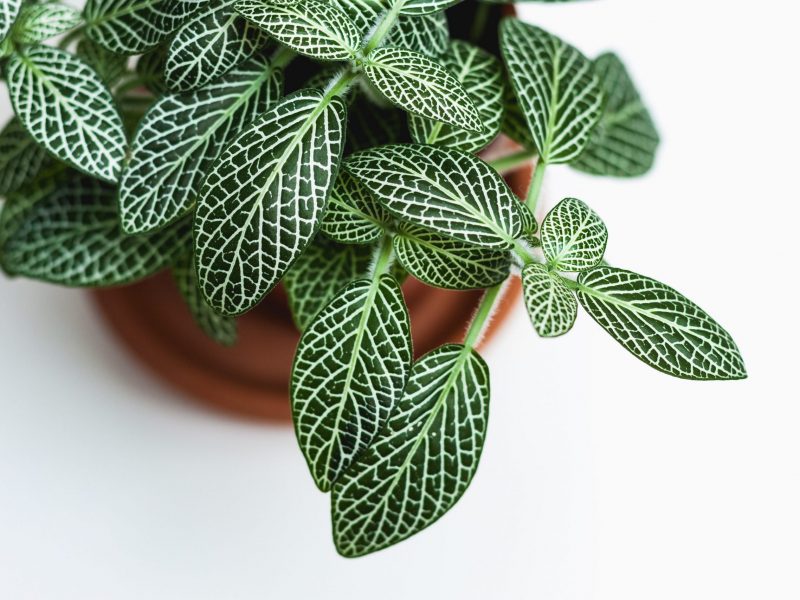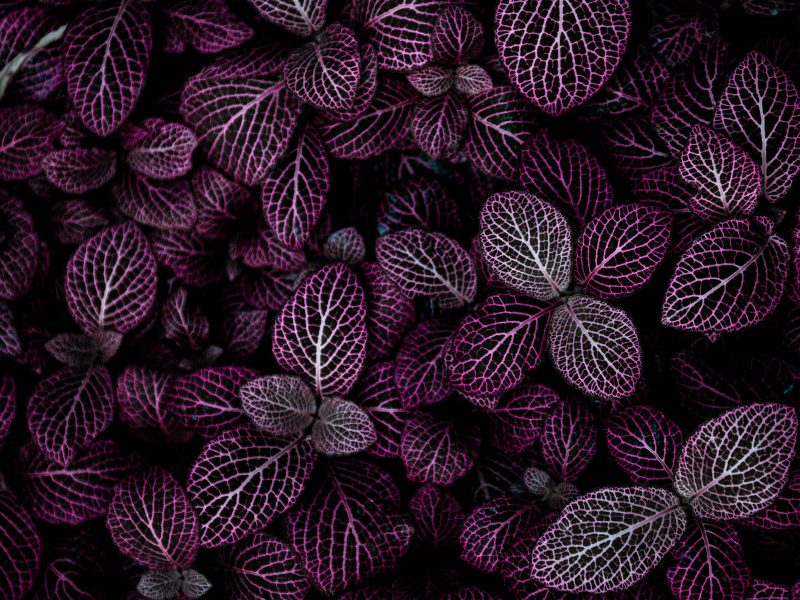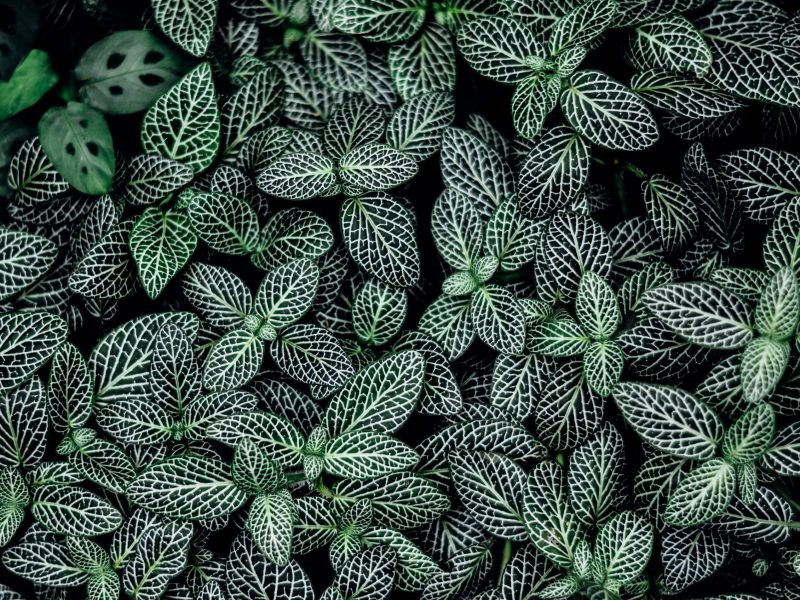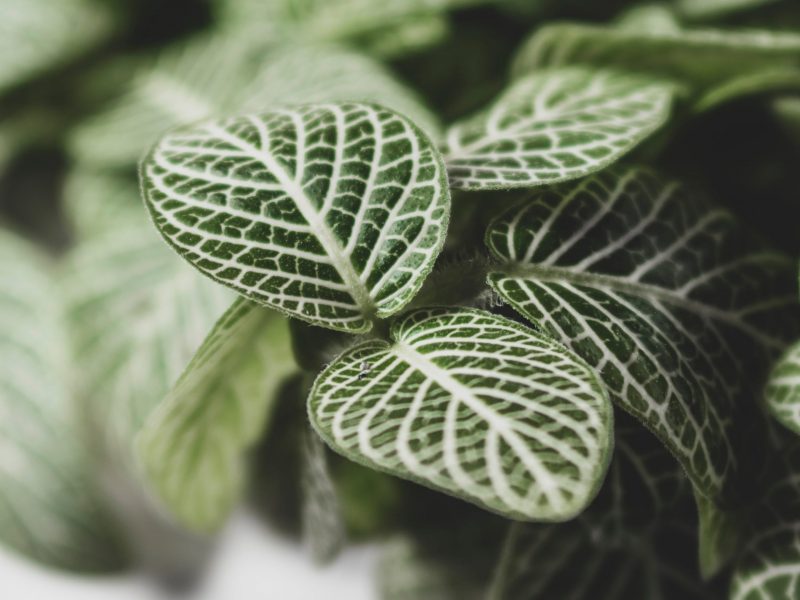Nerve Plant

Introduction to Nerve Plants
The Nerve Plant, or Fittonia as it is scientifically known, boasts impressive leaf patterns with veiny, bright lines coursing through its lush, green foliage. But don’t be fooled by its delicate appearance – the Nerve Plant is actually quite a hardy and adaptable houseplant,making it an excellent choice for both experienced and novice plant owners alike.
Native to the tropical rainforests of South America, this low-growing creeper brings a touch of the jungle into your living room. The Nerve Plant’s compact size and striking leaf designs make it a popular choice for indoor gardeners looking to add a splash of colour and texture to their plant collection.
In our guide, you’ll learn everything you need to know to care for your Nerve Plant, from watering and feeding to light requirements and propagation!
Different Types of Nerve Plants
Known for their striking foliage, Nerve Plants come in a variety of types, each offering unique features that can add a touch of elegance to your indoor garden. From subtle to bold, there’s a type of Fittonia that can fit anyone’s aesthetic taste.
Fittonia albivenis: This is perhaps the most common species of Fittonia. It’s easily recognisable by its dark green leaves adorned with contrasting white or silver veins.
Fittonia argyroneura: Argyroneura boasts a gorgeous silver veining pattern on rich green leaves. It’s a popular choice for those who prefer a more subdued look.
Fittonia verschaffeltii: Verschaffeltii features a stunning mosaic of red, pink, or white veins against a dark green backdrop. It’s a real show-stopper and can add a pop of colour to any room.
Fittonia ‘Red Anne’: As the name suggests, ‘Red Anne’ sports intense red foliage with a crinkled texture. The veins are typically silver or white, providing a beautiful contrast.
Fittonia ‘White Star’: The ‘White Star’ stands out with its brilliant white veins against deep green leaves. It’s a strikingly beautiful variety that’s sure to captivate.
Understanding the Nerve Plant: Origins and Characteristics
Known for its brilliantly patterned and deeply veined foliage, Never Plants come in striking shades of red, white, or pink, that contrast beautifully with the lush green,
Part of the Acanthaceae family, a group known for their diverse and eye-catching flora, Nerve Plants adapt well to a range of indoor environments, making them a popular choice for homes and offices.
In its native habitat, the Nerve Plant thrives in the understory layer of the rainforest, indicating its preference for indirect light and high humidity. With its low-growing, spreading habit, it is typically found carpeting the forest floor or adorning the branches of larger trees.
Purple Nerve Plant

Nerve Plant Light Requirements
For your Nerve Plant to truly thrive, the right lighting conditions are paramount. Indirect, bright light is the key to maintaining healthy new growth. It’s important to ensure your plant is exposed to enough light to maintain its vibrant foliage, but direct sunlight can scorch the leaves.
Too little light can be just as detrimental as too much. Insufficient light exposure may cause your Fittonia’s gorgeous leaf patterns to fade, and can hamper growth. If your plant seems to be growing leggy or if the vibrancy of its leaves is dulling, it may be crying out for more light.
In these circumstances, consider using a grow light. These are specifically designed to mimic the natural light spectrum, providing your plant with the light it craves.
Watering your Nerve Plant: Top Tips
As a tropical plant, your Nerve Plant (Fittonia) has a deep love for moist soil. However, it doesn’t like being soaked. That’s why monitoring the soil moisture often is crucial to know when it needs more water, and when you might need to wait a couple more days.
Frequency of watering
Watering frequency for your Nerve Plant depends largely on environmental factors. However, a good rule of thumb is to water once the top inch of soil feels dry. In favourable conditions, this usually equates to once or twice a week during summer and less during winter (roughly once every 10-12 days).
Amount
When watering, aim to keep the soil evenly moist but never waterlogged. Overwatering can lead to root rot, an unwelcome guest in any plant pot. Make sure you water until moisture runs through the drainage holes as this is a good indication you have evenly watered the soil. You should then remove any excess water about 10-15 minutes after watering to ensure the roots aren’t drowning in a puddle of water.
Water Quality
Tap water is completely fine to use on your Nerve Plant unless you live in an area with extremely hard water. The build-up of minerals in the tap water can damage the roots over time. If you do live in a hard water area, try using rainwater, distilled water or leave the tap water out for 24 hours before watering your plants to let the minerals evaporate.
Seasonal Changes
In winter, when the plant is dormant, reduce watering frequency. The cooler temperatures and reduced daylight cause the plant’s growth to slow, which means it requires less water. The risk of root rot does increase during winter so be mindful of that.
How and When to Fertilize your Nerve Plant
The Right Fertiliser for Your Nerve Plant
Your Fittonia isn’t fussy when it comes to fertilizer, but it does have its preferences. A balanced, water-soluble houseplant fertiliser is the way to go. Opt for one that has a 10:10:10 ratio of nitrogen, phosphorus, and potassium for optimal growth.
When and How Often to Fertilise
Only fertilize your Nerve Plant during the growth period of spring and summer. During this time, it’s ideal to fertilise every 4-6 weeks. During the winter months, the plant enters a resting phase and does not require any fertilisation.
How to Apply Fertiliser
Dilute your chosen fertiliser according to the package instructions, then water your plant as usual with the fertiliser-water mix. Make sure to thoroughly wet the soil, but don’t let it become waterlogged. Overfertilising or fertilising dry soil can lead to root burn so it’s better to be cautious than over-fertilize.
Humidity Levels: Why they Matter and How to Manage Them
Humidity plays a critical role in the survival and growth of your Nerve Plant. Fittonia, being a tropical plant, thrive in a high humidity environment, imitating its native rainforest habitat.
Understanding Humidity Requirements
The Nerve Plant prefers humidity levels between 50% to 70%. However, it can tolerate levels as low as 30% for short periods of time. Remember that if the humidity drops below this level, the plant’s leaves might start to brown and dry out over time.
How to Increase Humidity
Keeping your Fittonia happy with the right humidity levels can be a bit of a challenge, especially in drier climates or during winter. However, you’ll be very happy to know that there are several easy, cheap (often free) ways to increase the humidity for your Fittonia.
- Grouping plants together: This creates a microclimate with higher humidity levels, as plants release moisture into the air.
- Using a pebble tray: Just place your plant pot on a tray filled with pebbles and water. As the water evaporates, it increases the humidity around the plant.
- Investing in a humidifier: This is a more expensive method but is great at providing consistent humidity levels. This is particularly beneficial during dry winter months.
- Misting: Spraying your plant with a fine mist of water can also help increase humidity. However, do this with caution as over-misting can lead to fungal problem on the leaves.
Monitoring Humidity Levels
Keeping track of humidity levels is essential. You can use a digital hygrometer for this. It’s a small investment that gives you accurate readings and helps you adjust measures as needed. Most digital thermometers actually have humidity monitors built in which is a win-win and a great investment for your plants.
Temperature Requirements for a Nerve Plant
To emulate the warm, tropical climates of their natural South American habitats, Nerve Plants prefer temperatures between 16°C – 27°C (60-80°F).
Your Fittonia will not tolerate temperatures below 10°C (50°F), so avoid drafty windows and cold spots in your home.
How will you know if your plant is too cold? The first signs are wilting leaves. If this happens, move your plant to a warmer spot and it should perk up again.
But it’s not just cold temperatures that you need to be wary of as they will dry out and crisp up if exposed to high heat. Be careful that your Nerve Plant isn’t too close to heating vents, radiators or cookers as this can dry out the plant very quickly.
Top tip: Make sure to have a digital thermometer that you can place next to your plants to monitor the temperature level. This will allow you to spot any temperature extremes before they’ve caused any issues for your plants.
Nerve Plant Leaf Close Up

Pruning a Nerve Plant: Tips and Tricks
Pruning your Nerve Plant is not only beneficial for its health but also adds to its aesthetic appeal. Properly pruned plants are more likely to grow stronger and bushier. In this section, we will go through the best practices for pruning your Fittonia to ensure it thrives.
When to Prune
The best time to prune your Fittonia is during the growing season, typically from early spring to late summer. During this period, the plant will recuperate from pruning more quickly and use the energy to develop new growth.
How to Prune
When pruning your Fittonia, make sure to use a sharp, clean pair of scissors or pruning shears. Cut back leggy stems to the desired length, making sure to cut just above a leaf node. This encourages bushier growth and a more compact appearance.
Pruning for Health
Pruning isn’t just for aesthetics. It’s also crucial for the health of your Nerve Plant. If you notice any yellow, brown, or wilted leaves, prune them off right away. This prevents the spread of disease and allows the plant to focus its energy on new, healthy growth.
Nerve Plant Propagation: How to Expand Your Collection
Methods of Propagation
There are two primary methods for propagating your Nerve Plant: stem cuttings and division.
- Stem Cuttings: This is the most popular method and involves taking a healthy cutting from the mother plant and rooting it in water or potting mix. This is the best method for less mature and smaller plants.
- Division: This method involves separating a larger plant into two or more smaller ones. It’s ideal for mature plants that need repotting. This is also the quicker and more successful method as it doesn’t rely on cuttings growing an entirely new root system.
Steps for Stem Cutting Propagation
- Select a Healthy Stem: Choose a stem that’s approximately 4 inches long with at least two sets of leaves.
- Prepare the Cutting: Cut just below a node (the point from where leaves grow) using a clean, sharp knife.
- Root the Cutting: Place the cutting in a container with fresh water or a moist potting mix. Ensure that the node is submerged or in contact with the soil.
- Wait for Roots to Grow: Within a few weeks, roots should start to form. Once they’re about an inch long, your new plant is ready for potting.
Steps for Division Propagation
- Remove the Plant: Gently take the plant out of its pot, being careful not to damage the root system.
- Separate the Plant: Use your hands or a sterile knife to divide the plant into smaller sections. Each section should contain roots and leaves.
- Repot: Place each division in a new pot with fresh potting mix, ensuring to cover the roots adequately.
- Water Generously: Water each new plant thoroughly and place them in a warm location with indirect light.
How and When to Repot your Nerve Plant
When to Repot a Fittonia
Inspecting your Nerve Plant will provide signs when it’s time to repot. When roots start emerging from the drainage holes or the plant’s growth seems stunted, it’s time for a new pot. Spring and summer are the best seasons for repotting, aligning with the plant’s natural growth cycle.
On average, you will probably want to repot your Nerve Plant every 1-2 years but it does very much depend on each individual plant.
Choosing the Right Pot
When choosing a new pot, size matters. Select a pot only 1-2 inches larger in diameter than the current one. A pot that’s too large may lead to overwatering and root rot, as the excess soil retains more moisture. It can also lead to increased instability so it’s important not to scale up the pot size too quickly.
How to Repot a Fittonia Plant
- Prepare the new pot by adding a layer of fresh potting mix at the bottom.
- Gently remove the plant from its current pot.
- Inspect the roots for signs of disease or rot, trimming away any unhealthy sections.
- Place the plant in the new pot and fill around it with potting mix, pressing down gently.
- Water thoroughly and place the pot in a shaded location for a few days to help your plant acclimate.
Top down view of Nerve Plants

Flowers on a Nerve Plant
Flowering on a Nerve Plant or Fittonia is not a common occurrence. This is mainly because these plants are cultivated for their ornate foliage rather than their flowers so don’t rest too much hope of seeing flowers each year.
If your Fittonia does bloom, you’ll notice small, non-descript flowers. These are typically white to off-white in colour. They may not be as eye-catching as the plant’s leaves, but they’re still a fascinating aspect of this plant’s life cycle.
It’s important to note that flowering can drain energy from the plant. If you prefer the lush, intricate leaf patterns that Fittonia is famous for, you might want to remove the flowers. This helps the plant to direct its energy back to the leaves.
A tip for encouraging flowering: Provide consistent, high humidity and indirect light. However, remember that flowering is not a sign of a healthy plant — it’s just a bonus.
When and Why does a Nerve Plant Flower?
Nerve Plants bloom when they’re mature, usually several years into their lifespan. They flower when they’re comfortable and well-cared for. This means they’re getting the right balance of light, humidity, and temperature. However, it’s worth noting that flowering is not a reliable sign of plant health. Some Nerve Plants might never bloom, even in ideal conditions. On the other hand, a plant under stress might flower in a desperate bid to reproduce before it dies.
Cleaning your Nerve Plant
Keeping your Nerve Plant clean is not about aesthetics. It’s a vital part of plant care that can significantly impact the overall health and vitality of your Fittonia.
Why it’s important: Dust accumulation on the leaves can limit the plant’s photosynthesis process as it blocks light (yes even a very thin layer of dust can make a difference). In addition, it can also invite pests and diseases. Therefore, it’s necessary to keep your Nerve Plant clean and dust-free.
How to Clean your Nerve Plant
- Gently dust off: Start by gently dusting off the leaves with a soft brush or cloth. Always remember to be gentle, as the leaves are delicate and can get damaged easily.
- Misting: After dusting, mist the leaves lightly with water. This not only cleans the plant further, but also provides it with necessary humidity.
- Wipe off: Finally, gently wipe off the water using a clean cloth. This removes any remaining dust and prevents water spots from forming on the leaves.
This simple cleaning routine can work wonders for your Nerve Plant’s health. However, remember to clean in the morning or early afternoon, so the plant has enough time to dry before the colder night temperatures.
Timing and Frequency
How often should you clean your Nerve Plant? Well, it largely depends on the environment. If your plant is in a dusty area, you might need to clean it weekly. But in most cases, a bi-weekly or monthly cleaning should be sufficient.
Nerve Plant Toxicity
Fittonia is considered non-toxic to humans and pets. This doesn’t mean that it’s edible, but it does mean that if it’s accidentally ingested, it’s unlikely to cause serious harm. However, individual reactions can vary, and it’s always wise to keep houseplants out of reach of curious cats, dogs, or children.
While it’s not poisonous, the sap from a Fittonia can cause mild irritation if it comes into contact with the skin or eyes. If this occurs, rinse the affected area with lukewarm water, and if symptoms persist, seek medical advice.
Frequently Asked Questions: Nerve Plant Care
What is the best light condition for a Nerve Plant?
A Nerve Plant thrives in bright, indirect light. Although these plants can tolerate low light conditions, they may lose their vibrant vein colouration. Avoid placing your Nerve Plant under direct sunlight as it can scorch the leaves.
How often should I water my Nerve Plant?
The watering frequency for a Nerve Plant largely depends on the humidity, temperature, and light conditions of the environment. Generally, it’s best to keep the soil consistently moist, but not waterlogged. Overwatering can lead to root rot, which these plants are quite sensitive to.
Do Nerve Plants need humidity?
Yes, they do! Nerve Plants are tropical plants and they enjoy a humid environment. Daily misting, placing a tray of water near the plant, or using a humidifier can help maintain the necessary humidity levels.
Is the Nerve Plant pet-friendly?
Good news for pet owners – Nerve Plants are non-toxic to cats and dogs. However, like any plant, they should not be ingested in large quantities. It’s always best practice to keep plants out of reach from curious pets.
Common Problems with Nerve Plants
Why has my Nerve Plant got yellow leaves?
If you notice that your Nerve Plant is developing yellow leaves, this is most commonly caused by overwatering. Check the moisture in the soil and adjust your watering schedule accordingly. Make sure that you have good drainage holes so that the soil does not become waterlogged.
Why does my Nerve Plant have dry, crispy brown leaves?
Crispy, dry brown leaves on your Nerve Plant will most probably be caused by a lack of humidity. As Nerve Plant are native to tropical rainforests, they may suffer in dry homes. You can find out more about increasing the humidity for your Nerve Plant here to avoid further brown leaves.
Why is my Nerve Plant dropping leaves?
If your Nerve Plant is dropping leaves, it may be due to cold temperatures. If your plant is next to drafty windows, doors or AC vents, the cold air may be stressing your plant out meaning it loses some of its leaves.














